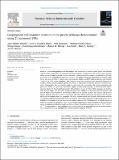| dc.contributor.author | Muinde, Jane Mbithe | |
| dc.contributor.author | Bhanu, Devi R. Chandra | |
| dc.contributor.author | Neumann, Rita | |
| dc.contributor.author | Oduor, Richard Okoth | |
| dc.contributor.author | Kanja, Wangu | |
| dc.contributor.author | Kimani, Joseph Kagunda | |
| dc.contributor.author | Mutugi, Marion W. | |
| dc.contributor.author | Smith, Lisa | |
| dc.contributor.author | Jobling, Mark A. | |
| dc.contributor.author | Wetton, Jon H. | |
| dc.date.accessioned | 2022-08-20T11:33:29Z | |
| dc.date.available | 2022-08-20T11:33:29Z | |
| dc.date.issued | 2021-07 | |
| dc.identifier.citation | Jane Mbithe Muinde, Devi R. Chandra Bhanu, Rita Neumann, Richard Okoth Oduor, Wangu Kanja, Joseph Kagunda Kimani, Marion W. Mutugi, Lisa Smith, Mark A. Jobling, Jon H. Wetton, Geographical and linguistic structure in the people of Kenya demonstrated using 21 autosomal STRs, Forensic Science International: Genetics, Volume 53, 2021, 102535, ISSN 1872-4973, https://doi.org/10.1016/j.fsigen.2021.102535. | en_US |
| dc.identifier.issn | 1872-4973 | |
| dc.identifier.other | DOI:10.1016/j.fsigen.2021.102535 | |
| dc.identifier.uri | https://repository.amref.ac.ke/handle/123456789/781 | |
| dc.description | This is an open access article under the CC BY license (http://creativecommons.org/licenses/by/4.0/). | en_US |
| dc.description.abstract | Kenya is a diverse and populous nation that employs DNA evidence in its criminal justice system, and therefore requires reliable information on autosomal STR allele frequency variation across the country and in its many ethnic groups. In order to provide reference data and to assess population structure, we analysed the 21 autosomal STRs in the GlobalFiler multiplex in a sample of 510 indigenous Kenyans representing the country’s eight former provinces, 43 of its 47 counties, three main linguistic families and all 29 ethnic groups that each comprise >0.5% of the 2019 census population. The indigenous population originated from successive migrations of Cushitic, Nilotic and Bantu speaking groups who settled in regions that suited their distinctive sustenance lifestyles. Consequently, they now largely reside in a patchwork of communities with strong associations with particular counties and provinces and limited degrees of inter-group marriage, as shown by DNA donors’ ancestry details. We found significant genetic differentiation between the three Nilotic language sub-families, with Western Nilotes (the Luo ethnic group) showing greater similarity to the Bantu than the Southern and Eastern Nilotes which themselves showed closer affinity to the Cushitic speakers. This concurs with previous genetic, linguistic and social studies. Comparisons with other African populations also showed that linguistic affiliation is a stronger factor than geography. This study revealed several rare off-ladder alleles whose structure was determined by Sanger sequencing. Among the unusual features that could affect profile interpretation were a deletion of Amelogenin Y but no other forensic marker (autosomal or Y-chromosomal), a triallelic pattern at TPOX and an extremely short SE33 allele falling within the expected size range of D7S820. Compared with the currently implemented Identifiler multiplex, Random Match Probabilities decreased from 6.4 × 10–19 to 3.9 × 10–27. The appreciation of local population structure provided by the geographically and ethnically representative sample in this study highlights the structured genetic landscape of Kenya. | en_US |
| dc.description.sponsorship | A grant to L.S. and M.A.J. from ELRHA (Enhancing
Learning and Research for Humanitarian Assistance), a philanthropic
donation from Ring for Peace, a University of Leicester International
Research Development Fund award, and a GCRF Global Impact Accelerator
Account award to the University of Leicester | en_US |
| dc.language.iso | en | en_US |
| dc.publisher | Elsevier | en_US |
| dc.subject | Kenya | en_US |
| dc.subject | Autosomal STRs | en_US |
| dc.subject | Population structure | en_US |
| dc.subject | Linguistic structure | en_US |
| dc.subject | Global | en_US |
| dc.subject | Filer | en_US |
| dc.title | Geographical and Linguistic Structure in the People of Kenya Demonstrated Using 21 Autosomal STRs | en_US |
| dc.type | Book | en_US |

